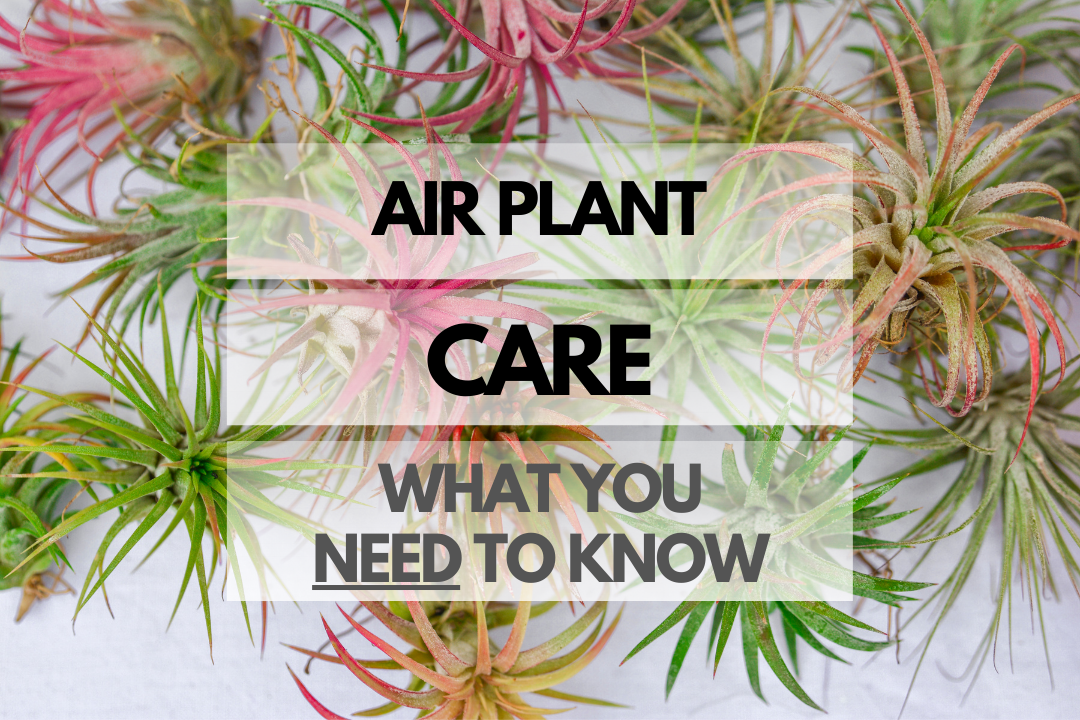Air Plant Care Guide
Air plants, or Tillandsia, are unique and versatile plants that thrive without the need for soil. They are perfect for those who want to add a touch of natural beauty to their indoor or outdoor space without the fuss of traditional plant care. In this guide, we’ll explore the essential care tips for keeping your air plants happy and healthy.
Quick Reference Table: Caring for Air Plants
| Aspect | Requirement |
|---|---|
| Sunlight | Bright, indirect light |
| Soil | None required |
| Watering | Misting or soaking 1-2 times per week |
| Pruning | Remove dead or damaged leaves as needed |
| Temperature | 50-90°F (10-32°C) |
Air Plant Sunlight: Do They Need It and How Much?
Air plants do need sunlight to thrive, but they prefer bright, indirect light. Exposure to direct sunlight for extended periods can cause the leaves to burn and become damaged. Placing your air plants near a window with filtered light or in a well-lit room is ideal. If you’re growing air plants outdoors, provide them with dappled shade or hang them under an awning or tree to protect them from harsh sunlight.
Air Plant Soil Tips
One of the most intriguing aspects of air plants is that they don’t require soil to grow. Instead, they absorb nutrients and moisture from the air through their leaves. This makes them incredibly low-maintenance and allows for a wide range of creative display options, such as mounting them on driftwood, placing them in glass terrariums, or hanging them in decorative air plant holders.
Air Plant Watering and Frequency
While air plants don’t need soil, they do require moisture. There are two main methods for watering air plants: misting and soaking. Misting involves spraying the plant with water 1-2 times per week, ensuring that the entire plant is dampened. Soaking involves submerging the plant in water for 20-30 minutes once a week. After watering, gently shake off any excess water and allow the plant to air dry completely to prevent rot.
Pruning Air Plants Properly
Pruning air plants is a simple process that helps keep them looking their best. To prune your air plant, use a clean pair of scissors or pruning shears to remove any dead, damaged, or discolored leaves. Be sure to cut as close to the base of the leaf as possible, without damaging the main stem.
Optimal Air Plant Temperature: Can They Tolerate the Cold?
Air plants prefer temperatures between 50-90°F (10-32°C) and can tolerate a range of indoor and outdoor environments. However, they are sensitive to extreme cold and should be protected from frost and freezing temperatures. If you live in a region with cold winters, bring your air plants indoors or provide them with adequate insulation to keep them warm.
Common Air Plant Problems
Browning or Yellowing Leaves
If your air plant’s leaves are turning brown or yellow, it could be a sign of underwatering or exposure to direct sunlight. Ensure that you’re providing your plant with adequate moisture and move it to a location with bright, indirect light.
Rotting
Rotted air plants are often a result of overwatering or not allowing the plant to dry properly after watering. To prevent rot, be sure to shake off excess water and let the plant air dry completely before placing it back in its display.
Pests
While air plants are generally pest-resistant, they can occasionally be affected by mealybugs or scale insects. If you notice pests on your air plant, treat the plant with a mixture of water and a few drops of mild dish soap. Gently wipe the affected areas with a soft cloth or cotton swab to remove the pests.
Air Plant Outdoors vs Indoors
Air plants can be grown both outdoors andindoors, each with its own set of advantages and disadvantages.
| Location | Pros | Cons |
|---|---|---|
| Indoors |
|
|
| Outdoors |
|
|
Best Pots for Air Plants
Since air plants do not require soil, traditional pots are unnecessary. Instead, consider using a variety of creative containers and displays to showcase your air plants. Some popular options include:
- Wire or mesh baskets
- Glass terrariums or globes
- Driftwood, cork bark, or other natural materials for mounting
- Decorative air plant holders designed specifically for Tillandsia
When choosing a display for your air plants, ensure there is adequate airflow and consider how the container will affect the plant’s access to light and water.
Air Plant Facts
Air Plant Benefits
- Low maintenance: Air plants don’t need soil and have minimal watering requirements, making them easy to care for.
- Space-saving: Since they don’t require traditional pots, air plants can be displayed in a variety of creative ways, making them perfect for small spaces.
- Purify the air: Like other plants, air plants help improve air quality by absorbing carbon dioxide and releasing oxygen.
- Stress relief: Caring for and being around plants, including air plants, can reduce stress and promote a sense of well-being.
Growth Rates: How Fast Do They Grow?
Air plants generally grow slowly, with most species taking several years to reach maturity. Their growth rate depends on factors such as light, temperature, and humidity. Providing optimal care conditions will encourage healthy and steady growth.
Air Plant Lifespan
Air plants can live for several years, with some species living up to 20 years or more under the right conditions. After flowering, air plants will produce pups, or offsets, which can be separated from the mother plant to create new plants, ensuring a continuous cycle of growth.
Are Air Plants Safe?
Air plants are non-toxic and safe to have around children, pets, and other animals. However, it’s always a good idea to keep plants out of reach of curious pets and children, as ingesting plant material could cause digestive upset.
Air Plant Flowers
Air plants produce colorful and unique flowers that can last for several weeks to months. Flowering is a one-time event in an air plant’s life, and it signals the beginning of the plant’s reproductive cycle. After flowering, the plant will produce pups that can be separated and grown into new plants.
Air Plant Types and Varieties
Tillandsia ionantha
Tillandsia ionantha is a popular air plant variety known for its small size and vibrant colors. When in bloom, the leaves turn bright red or purple, and the plant produces a tubular, violet flower. This variety is perfect for displays in small terrariums or mounted on decorative objects.
Tillandsia xerographica
The Tillandsia xerographica is a stunning air plant variety with thick, silvery-green leaves that curl and twist, creating a unique rosette shape. This slow-growing plant can reach up to 12 inches in diameter and produces a tall, multi-branched flower spike with bright yellow flowers when it blooms.
Tillandsia caput-medusae
Tillandsia caput-medusae, also known as the Medusa’s Head air plant, features long, snake-like leaves that give the plant its unique appearance. This variety produces a bright red flower spike with tubular purple flowers when in bloom.
Tillandsia aeranthos
The Tillandsia aeranthos is a small to medium-sized air plant with stiff, spiky leaves and a compact growth habit. It produces a tall flower spike with multiple bright pink bracts and tubular purple or blue flowers.
Air Plant Pros and Cons
| Pros | Cons |
|---|---|
|
|
Air Plant Cost
Air plants are generally affordable, with small to medium-sized plants ranging in price from $3 to $15, depending on the species and size. Larger or rarer varieties may cost more. Purchasing air plants in bulk or as part of a collection can be a cost-effective way to grow your air plant collection.
Where to Buy Air Plants
Air plants can be purchased at localnurseries, garden centers, or specialty plant shops. They are also widely available online through various retailers, such as Etsy, Amazon, and dedicated air plant websites like Air Plant Supply Co. and The Air Plant Shop.
Is Air Plant Propagation in Water Possible?
Air plant propagation in water is generally not recommended, as air plants absorb nutrients and moisture through their leaves and do not require soil or water for root growth. To propagate air plants, it’s best to wait for the mother plant to produce pups (offsets) and then gently separate them once they are about one-third the size of the parent plant.
Additional Resources
FAQ for Air Plant Care
Are air plants toxic to cats?
No, air plants are non-toxic to cats. However, it’s best to keep plants out of reach to prevent ingestion, which could cause digestive upset.
Are air plants toxic to dogs?
No, air plants are non-toxic to dogs. As with cats, it’s a good idea to keep plants out of reach to prevent ingestion and potential digestive issues.
Are air plants toxic to kids?
Air plants are non-toxic and safe for children. However, it’s always a good idea to teach children not to eat plants and to keep plants out of the reach of very young children.
How tall do air plants get?
Air plant size varies depending on the species. Some remain small, around 1 to 3 inches, while others can grow up to 12 inches or more in diameter. Most air plants grow slowly and will take several years to reach their full size.
Can air plants live outside?
Air plants can live outside in mild climates with adequate humidity and protection from direct sunlight and extreme temperatures. In colder or drier climates, air plants will need to be brought indoors or provided with additional humidity and protection from the elements.
Are air plants poisonous?
No, air plants are not poisonous and are considered non-toxic to humans, pets, and other animals.
How often should I water my air plant?
Watering frequency for air plants depends on the species, climate, and environment. In general, air plants should be soaked or misted with water 1 to 3 times per week. Ensure the plant is allowed to dry completely between waterings to prevent rot.

